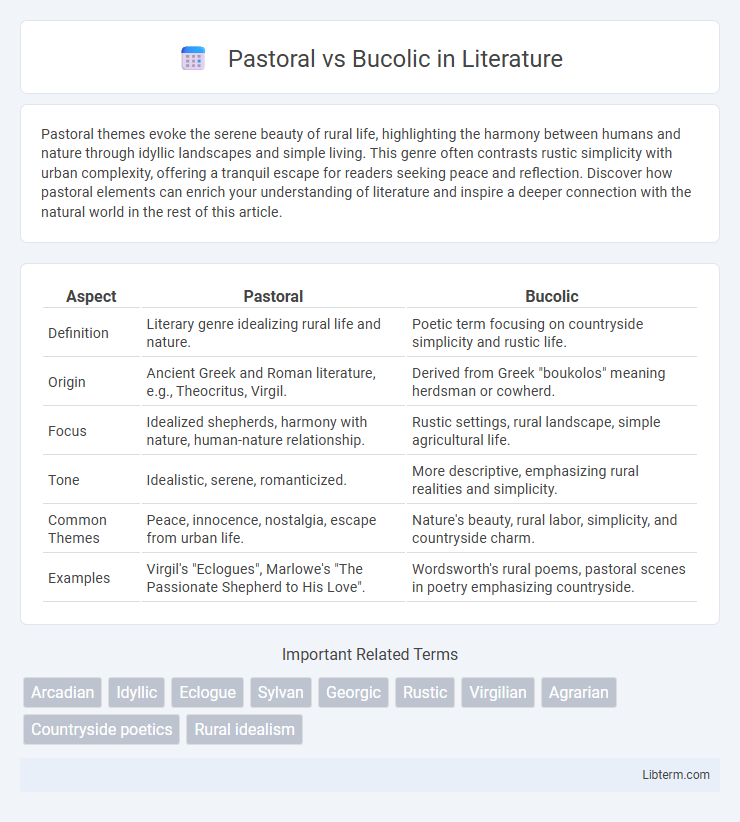Pastoral themes evoke the serene beauty of rural life, highlighting the harmony between humans and nature through idyllic landscapes and simple living. This genre often contrasts rustic simplicity with urban complexity, offering a tranquil escape for readers seeking peace and reflection. Discover how pastoral elements can enrich your understanding of literature and inspire a deeper connection with the natural world in the rest of this article.
Table of Comparison
| Aspect | Pastoral | Bucolic |
|---|---|---|
| Definition | Literary genre idealizing rural life and nature. | Poetic term focusing on countryside simplicity and rustic life. |
| Origin | Ancient Greek and Roman literature, e.g., Theocritus, Virgil. | Derived from Greek "boukolos" meaning herdsman or cowherd. |
| Focus | Idealized shepherds, harmony with nature, human-nature relationship. | Rustic settings, rural landscape, simple agricultural life. |
| Tone | Idealistic, serene, romanticized. | More descriptive, emphasizing rural realities and simplicity. |
| Common Themes | Peace, innocence, nostalgia, escape from urban life. | Nature's beauty, rural labor, simplicity, and countryside charm. |
| Examples | Virgil's "Eclogues", Marlowe's "The Passionate Shepherd to His Love". | Wordsworth's rural poems, pastoral scenes in poetry emphasizing countryside. |
Understanding Pastoral and Bucolic: Key Definitions
Pastoral refers to literature or art that idealizes rural life, often emphasizing shepherds and the simplicity of agricultural living, while bucolic specifically evokes the charm and tranquility of the countryside. Pastoral works frequently explore themes of innocence, nature, and harmony, portraying an idealized version of rural existence. Bucolic emphasizes peaceful, rustic settings, capturing the essence of countryside landscapes and pastoral livelihoods.
Historical Origins of Pastoral and Bucolic Traditions
The pastoral tradition traces its origins to ancient Greek literature, particularly the works of Theocritus in the 3rd century BCE, who idealized rural life through poems known as idylls. The bucolic tradition, closely related but distinct, emerged from the Latin term "bucolicus," rooted in Virgil's "Eclogues," which expanded the pastoral form by emphasizing poetic depictions of shepherd life in the Roman countryside. These historical foundations shaped the symbolic portrayal of nature and rustic simplicity, influencing Western literature and art for centuries.
Distinct Features of Pastoral Literature
Pastoral literature emphasizes the idealized lives of shepherds and rural simplicity, often exploring themes of love, nature, and innocence through sophisticated dialogue and structured poetic forms. Its distinct features include the use of shepherd characters as symbolic representations of purity and harmony, along with metaphors that contrast urban corruption and rural virtue. The genre frequently incorporates dialogues and monologues reflecting philosophical ideas and critiques of contemporary society, distinguishing it from the more descriptive, idyllic focus of bucolic literature.
Characteristics of Bucolic Imagery
Bucolic imagery is characterized by its romanticized depiction of rural life, emphasizing serene landscapes, rustic simplicity, and the harmonious coexistence of nature and human activity. It often features elements such as idyllic meadows, shepherds tending flocks, and peaceful countryside scenes that evoke nostalgia and tranquility. Unlike broader pastoral themes, bucolic imagery specifically highlights the charm and beauty of rural settings, celebrating the natural environment and traditional rural livelihoods.
The Role of Nature in Pastoral vs Bucolic Works
Nature in pastoral works often symbolizes an idealized, harmonious environment where human life and natural beauty coexist, reflecting social or romantic themes. Bucolic literature emphasizes rural countryside scenes with more realistic, sometimes gritty depictions of shepherd life and agricultural labor, grounding the narrative in everyday nature. Both genres use nature as a key element, but pastoral idealizes it while bucolic presents a more authentic portrayal of rural existence.
Famous Pastoral Writers and Their Influence
Pastoral literature, characterized by its idealized portrayal of rural life, has been shaped by famous writers such as Virgil, whose "Eclogues" established foundational themes of harmony between humans and nature. English poets like Edmund Spenser and Christopher Marlowe further influenced the genre, weaving social commentary into their pastoral works. Their writings inspired subsequent literary movements and deepened cultural appreciation for pastoral themes, contrasting with the more decorative and romanticized depictions found in bucolic poetry.
Notable Bucolic Poets and Their Impact
Notable bucolic poets like Theocritus, Virgil, and Robert Frost significantly shaped pastoral literature by idealizing rural life and nature's simplicity. Their works emphasize idyllic landscapes and shepherd life, influencing the development of bucolic poetry as a distinct genre within pastoral tradition. This poetic focus on rustic themes contributes to sustaining and celebrating cultural connections to agrarian heritage and natural beauty.
Thematic Differences: Idyllic Life vs Rustic Reality
Pastoral literature idealizes rural life, emphasizing harmony between humans and nature through peaceful, idyllic landscapes and shepherd characters embodying simplicity and virtue. Bucolic works present a more grounded depiction of rustic existence, highlighting the challenges and hardships faced by rural inhabitants alongside the beauty of the countryside. The thematic difference lies in pastoral's romanticized tranquility contrasted with bucolic's realistic portrayal of everyday rural labor and life.
Contemporary Applications of Pastoral and Bucolic Concepts
Contemporary applications of pastoral concepts emphasize idealized rural life and the harmonious relationship between humans and nature, often reflecting environmental concerns and sustainable living. Bucolic themes in modern contexts highlight rustic simplicity and the charm of countryside settings, frequently used in art, literature, and design to evoke nostalgia and tranquility. Both pastoral and bucolic motifs serve as counterpoints to urbanization, influencing eco-tourism, literary genres, and cultural identity in contemporary society.
Pastoral and Bucolic: Comparative Analysis and Lasting Legacy
Pastoral and bucolic themes both evoke idealized rural landscapes, yet pastoral literature emphasizes human interaction with nature, often reflecting societal and philosophical ideals, while bucolic poetry focuses on the charm and simplicity of countryside life. The pastoral tradition traces its origins to ancient Greek literature, evolving through Renaissance and Romantic eras, influencing writers like Virgil and Wordsworth, whereas bucolic works capture everyday rural scenes without extensive allegorical meaning. Their lasting legacy endures in shaping modern ecological awareness, inspiring artistic representations of nature, and preserving cultural nostalgia for agrarian lifestyles.
Pastoral Infographic

 libterm.com
libterm.com